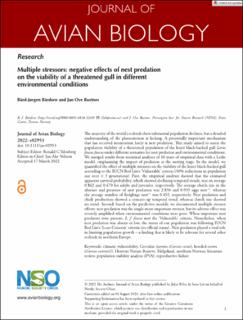| dc.contributor.author | Bårdsen, Bård-Jørgen | |
| dc.contributor.author | Bustnes, Jan Ove | |
| dc.coverage.spatial | Horsvær, Helgeland, northern Norway | en_US |
| dc.date.accessioned | 2023-11-17T12:31:27Z | |
| dc.date.available | 2023-11-17T12:31:27Z | |
| dc.date.created | 2022-05-24T11:56:23Z | |
| dc.date.issued | 2022 | |
| dc.identifier.citation | Journal of Avian Biology. 2022, . | en_US |
| dc.identifier.issn | 0908-8857 | |
| dc.identifier.uri | https://hdl.handle.net/11250/3103253 | |
| dc.description.abstract | The majority of the world's seabirds show substantial population declines, but a detailed understanding of the phenomenon is lacking. A potentially important mechanism that has received momentum lately is nest predation. This study aimed to assess the populationviability of a threatened population of the lesser black-backed gull Larus fuscus fuscus under different scenarios for nest predation and environmental conditions. We merged results from statistical analyses of 16 years of empirical data with a Leslie model, emphasising the impact of predation at the nesting stage. In the model, we quantified the effect of multiple stressors on the viability of the lesser black-backed gull according to the IUCN Red List's 'Vulnerable' criteria (30% reductions in population size over < 3 generations). First, the empirical analyses showed that the estimated apparent survival probability, which showed declining temporal trends, was on average 0.862 and 0.470 for adults and juveniles, respectively. The average clutch size in the absence and presence of nest predation was 2.836 and 0.935 eggs nest−1, whereas the average number of fledglings nest−1 was 0.452, respectively. Nest predation and chick production showed a concave-up temporal trend, whereas clutch size showed no trend. Second, based on the predictive models, we documented multiple stressor effects: nest predation was the single-most-important stressor, but its adverse effect was severely amplified when environmental conditions were poor. When important nest predators were present, L. f. fuscus met the 'Vulnerable' criteria. Nonetheless, when nest predation was absent or low, the status of our population was following IUCN Red List's 'Least Concern' criteria (its official status). Nest predation played a vital role in limiting population growth – a finding that is likely to be relevant for several other seabirds in northern Europe | en_US |
| dc.language.iso | eng | en_US |
| dc.rights | Navngivelse 4.0 Internasjonal | * |
| dc.rights.uri | http://creativecommons.org/licenses/by/4.0/deed.no | * |
| dc.subject | climatic vulnerability | en_US |
| dc.subject | Corvidae (ravens (Corvus corax) | en_US |
| dc.subject | hooded crows (Corvus conrnix) | en_US |
| dc.subject | Horsvær | en_US |
| dc.subject | Nature Reserve | en_US |
| dc.subject | Helgeland | en_US |
| dc.subject | northern Norway | en_US |
| dc.subject | literature review | en_US |
| dc.subject | population viability analysis (PVA) | en_US |
| dc.subject | reproductive failure | en_US |
| dc.title | Multiple stressors: negative effects of nest predation on the viability of a threatened gull in different environmental conditions | en_US |
| dc.title.alternative | Multiple stressors: negative effects of nest predation on the viability of a threatened gull in different environmental conditions | en_US |
| dc.type | Peer reviewed | en_US |
| dc.type | Journal article | en_US |
| dc.description.version | publishedVersion | en_US |
| dc.rights.holder | © 2022 The Authors | en_US |
| dc.subject.nsi | VDP::Zoologiske og botaniske fag: 480 | en_US |
| dc.subject.nsi | VDP::Zoology and botany: 480 | en_US |
| dc.source.pagenumber | 0 | en_US |
| dc.source.journal | Journal of Avian Biology | en_US |
| dc.identifier.doi | 10.1111/jav.02953 | |
| dc.identifier.cristin | 2026904 | |
| dc.relation.project | Andre: SEAPOP | en_US |
| dc.relation.project | Norges forskningsråd: 268482 | en_US |
| cristin.ispublished | true | |
| cristin.fulltext | original | |
| cristin.qualitycode | 1 | |

